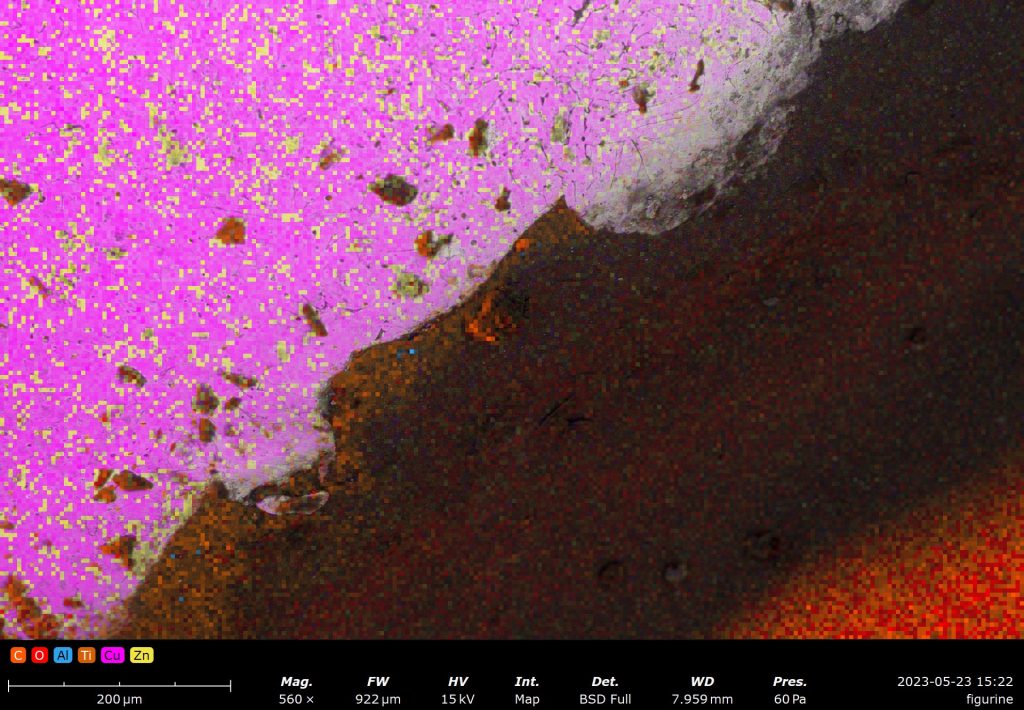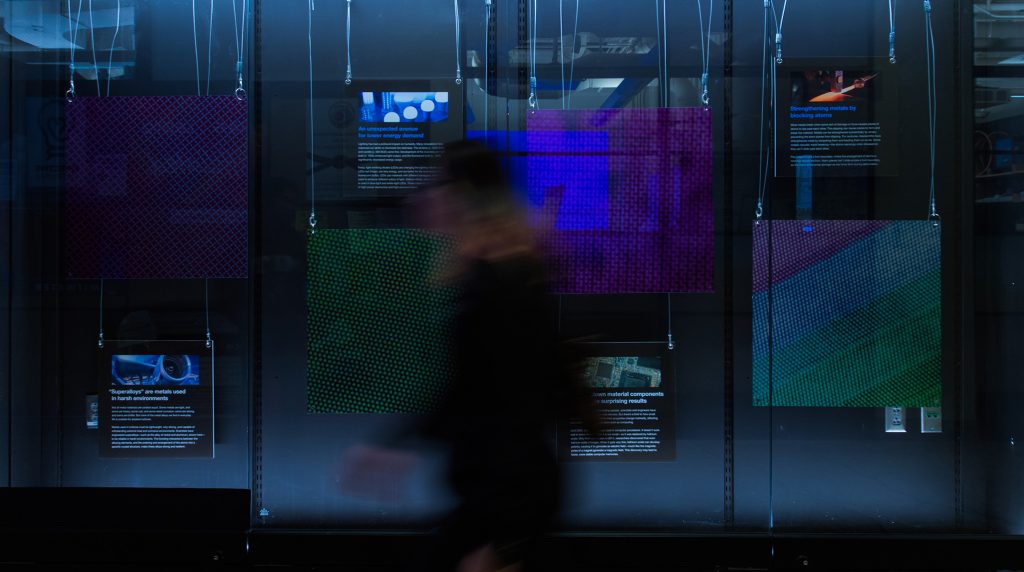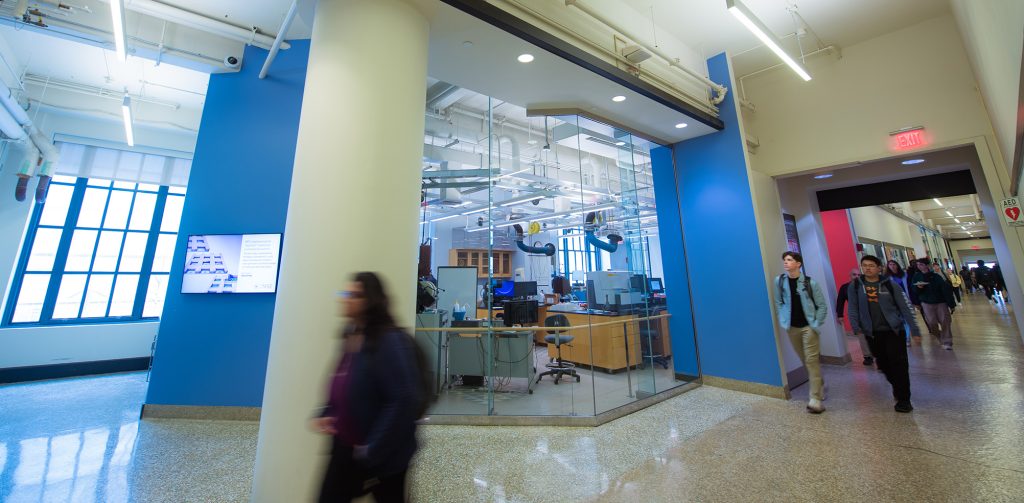Coming soon to the Infinite Corridor: A space to explore the infinitesimal

It started with a cat. A figurine kitty with a blue-green patina that indicated it was made of copper that had oxidized.
But was it? Maria Aguiar, a sophomore in the Department of Materials Science and Engineering (DMSE), didn’t know. So back in December, she told her mechanics class instructor about the figurine, a souvenir from a friend who had visited Greece.
“I said, ‘I have this little cat, and I don’t know what metal it is. Is there a way to find out?’”
That’s when Aguiar learned about the DMSE Breakerspace, a materials characterization laboratory with equipment for learning about the composition, structure, and behavior of materials.
Technically, the Breakerspace, due to open on MIT’s Infinite Corridor this summer, didn’t exist at the time. But some of the equipment was already in the department, including a scanning electron microscope that examines objects at the atomic level. So with the help of DMSE’s Associate Professor James LeBeau, Aguiar put the cat under the microscope. It detected copper, but what they found near the patina surprised them.
“We see huge traces of titanium and oxygen, and we’re like, ‘What in the world is this?’” Aguiar said. “And Jim said, ‘Oh, it’s paint.’”
Titanium dioxide is a white pigment used in paint for its brightness and color durability—it’s what changes the color to the desired shade. The cat had copper in it, but its authentic-looking oxide patina was painted on.
“It was interesting to see the discrepancy between what we expected and what we saw,” Aguiar said. “It turned out to be different, and we were able to explain it. And that is the scientific process.”
Hands-on learning
The Breakerspace is envisioned as a place where that process is replayed again and again by giving students direct access to instruments.
“The overarching goal is to give students hands-on aspects of materials science,” said LeBeau.
“This is meant for students to explore and learn things that are not a prescribed part of the curriculum. It’s meant to enable students to ask and answer their own questions.”
The lab is not just for materials science and engineering majors, though, said department head Professor Jeffrey Grossman.
“This is a new space that is open to the entire undergraduate community at MIT, whatever their major is and whatever their interests are,” said Grossman. “It’s for the biologist who wants to visualize the elements in a coffee bean. Or the philosopher who wants to know what makes a leaf that’s turned orange orange. Or the economics major with a paperclip in her pocket who thinks, ‘Hey, what’s this made of?’ Because we’re all curious about what things are made of, right? Well, you can come into this space and find out.”
The Breakerspace as a concept came from Grossman’s time teaching 3.091 (Introduction to Solid State Chemistry), a large class of mostly first-year students and an MIT general institute requirement, or GIR. Though the class has no lab component, Grossman saw the need for learning by doing. He’d frequently do demos—ranging from lighting hydrogen bubbles to showing how tempered glass can withstand baseballs being whipped at it but shatter when struck at its edges—and give students goody bags filled with experiments they could try at home to complement what they were learning in the lectures. They got crystal-building kits, for example, when they were learning about the atomic structure of solids.
“Hands-on learning has always been a passion for me,” Grossman said. “The idea is, get students the tools that make it easy for them to play with and explore their own curiosity, that let them see what’s inside of the things that make up the world.”
Whereas the makerspaces that dot MIT and other schools allow students to build things out of parts they make, the Breakerspace gives them the tools to investigate the parts themselves, to see what they’re made of and what they look like at different length scales, Grossman said. And though a major focus of materials science and engineering is making things—new materials with properties tailored for specific applications—it’s first about figuring out the composition of existing things, what gives them their strength and durability, what makes them brittle or elastic or tough.
“We don’t really see what makes one material better or worse than another. It’s all at the atomic scale, or it’s all at the micro scale,” said LeBeau. “It’s not something you could see with your eyes, but you can test it and you can validate a lot of the hypotheses through these characterization techniques.”
The Breakerspace will be the first of its kind at MIT—an access path to specialized equipment for answering questions students are just interested in. What does a key look like magnified 100,000 times, for example, or a piece of paper?
LeBeau’s specialization at DMSE is characterization. He develops new techniques for collecting and interpreting data from electron microscopy to better understand material properties. That knowledge can inform the design and optimization of new materials.
“I want to show why materials are so cool,” LeBeau said. “I’ve seen it time and time again on the microscope. I see students see at the nanoscale for the first time. Their eyes light up, and their jaws drop—they are seeing things that, in reality, very few people in the world see live.”
“Low barrier to entry”
The Breakerspace, now under construction in 8-102, formerly DMSE’s Laboratory for Advanced Materials, will actually be two spaces. One will be a lounge where students can grab free snacks—cereal is the food students in focus groups were most excited about; no milk or yogurt though. “Too messy,” said Grossman, “but I promise we’ll have the best coffee on campus.”
Next to the lounge will be a modern laboratory. State-of-the-art equipment students can use includes scanning electron microscopes, which scan a material sample using a beam of electrons to form an image; spectrometers—they measure the interaction of a material and electromagnetic radiation; and a scanning Raman microscope, which shines a laser onto a material sample and measures the scattered light to determine its composition and molecular structure.
The lab will also include equipment for preparing samples for the microscopes and mechanical testing tools, which test properties of materials such as strength and hardness.
All the Breakerspace equipment was chosen for its ease of use, requiring just a few minutes of training.
“We wanted a low barrier to entry,” said Grossman. “The idea is this is an open and welcoming space for students to just play around, honestly.”
The multipurpose nature of the Breakerspace is in the name itself, a play on “makerspace” but with the intention of letting students explore, test, even break materials—as well as a place to “take a break from your day and just hang out,” said Grossman.
Students will be able to analyze most anything they bring into the space—from aspirin tablets to batteries—but there will be a curated set of materials to explore as well, which will include polymers to electronic devices to materials from the natural world. There will also be content creation tools available, including cameras with tripods, microphones, and lighting, so students can document their work and share it on social media.
The team responsible for the Breakerspace design, organization, and management consists of Grossman, LeBeau, DMSE senior lecturer Mike Tarkanian, facilities manager Kevin Rogers, and Breakerspace manager Justin Lavallee, who will coordinate all training on the equipment. A generous donor is helping to fund the renovations, Grossman said.
About a half dozen instruments have already been acquired for the laboratory and were tested by students, Lavallee said. “Not only are we able to get them running instruments safely and collecting valid data quickly, but they are successfully interpreting that data and drawing conclusions about their characterization work.”
Operation outreach
The Breakerspace is the “crown jewel” of a new strategic outreach vision for DMSE, said Grossman, designed to illustrate how the characterization and synthesis of new materials lead to advances in medicine, renewable energy, electronics, and more. That includes a soon-to-launch new website, geared toward people who know little about materials science and engineering as well as toward experts, and an art exhibit, set into the walls of the future Breakerspace, which opened in March. The current installment is a series of atomic resolution images—arrangements of atoms in a material, as seen through a scanning electron microscope, by the LeBeau research group.
Grossman said the effort is not just about recruiting students. “It’s about making sure that people who are majoring in architecture or physics or any subject from any corner of MIT have better tools to learn why materials science and engineering is so important.”
For Aguiar, the sophomore who discovered something unexpected about her cat figurine, the Breakerspace will provide an opportunity to exercise her curiosity anytime she likes.
“I want to look at some rocks through the SEM,” Aguiar said, referring to the scanning electron microscope. “Especially the ones with funny crystal structures—pyrite has those perfect little cubes. Just being able to get a closer view of their structure I think would be really cool.”
For more information on the DMSE Breakerspace, write Justin Lavallee at jalavall@mit.edu


